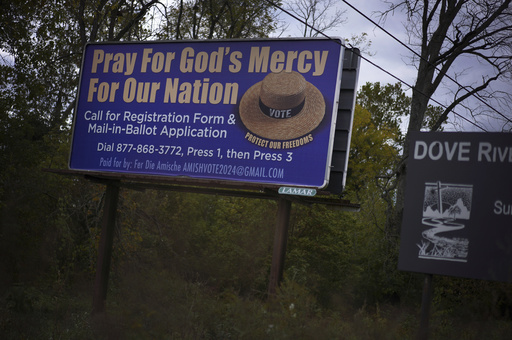
LANCASTER, Pa. — On a recent afternoon, an Amish individual traversed a bustling intersection in Pennsylvania’s Lancaster County in a horse-drawn buggy, moving past a billboard that boldly declared: “Pray for God’s Mercy for Our Nation.”
The advertisement prominently featured an image of a traditional wide-brimmed straw hat that is often associated with the Amish culture. To clarify its intended audience, the billboard noted its sponsorship by “Fer Die Amische,” which translates to “For the Amish” in Pennsylvania Dutch.
Studies indicate that the majority of Amish people do not participate in elections, a trend reflective of their longstanding tradition of separation from mainstream society. This is evident in their continued use of their dialect and reliance on horse-and-buggy travel.
Despite this, a small segment of the Amish community does engage in voting, making their numbers particularly significant in Pennsylvania, an influential swing state. Consequently, this demographic is being actively courted in the run-up to the elections, following decades of attempts to motivate greater participation among them.
Republicans are particularly focused on securing the Amish vote through a variety of methods, including advertisements, billboards, personal outreach, and community gatherings. Campaigners believe that the Amish may align with Republican ideals of reduced government intervention, deregulation, and the protection of religious freedoms.
“The Amish wish for the government to step back from their religious and business affairs,” stated U.S. Rep. Lloyd Smucker, a Republican whose district includes Lancaster County, home to a significant Amish population. Smucker, who shares an Amish heritage, anticipates a notable increase in Amish voter turnout, attributing this optimism to the visible enthusiasm within the community.
While there is potential for a slight uptick in Amish voter participation, experts caution against expecting any drastic impact on Pennsylvania’s election results. Steven Nolt, the director of the Young Center for Anabaptist and Pietist Studies at Elizabethtown College, points out that historically, voting is not a common practice among the Amish. “Historically, and in most communities today, voting is not part of their customs,” Nolt remarked, “and there is no indication that this will change in the foreseeable future.”
However, a few Amish communities in Lancaster and elsewhere have engaged in voting, which typically comprises less than 10% of their population, according to Nolt. He has been involved in meticulous research analyzing voting patterns within predominantly Amish areas, which includes painstaking cross-referencing of voter registers with church lists, a process that is not feasible to conduct in real-time during elections.
In total, approximately 92,000 Amish individuals reside in Pennsylvania, based on research from the Young Center, which compiles information from a diverse range of sources such as almanacs and directories. A significant percentage of this population, particularly in Lancaster County, consists of children, meaning less than half are of eligible voting age. In 2020, estimates indicated that roughly 3,000 Amish voted in the Lancaster area, with a few hundred participating in other regions.
Thus, even with a potential rise in participation, the numbers wouldn’t likely shift the electoral landscape significantly. In the 2020 election, the state was won by Democrat Joe Biden by roughly 80,000 votes.
The Amish are one among many religious and ethnic groups actively sought after by political candidates. “In competitive elections, every vote has value,” Nolt pointed out, but he reiterates that the Amish community’s voting numbers are not expected to reach the tens of thousands.
Nonetheless, Smucker remains hopeful that there will be a noticeable turnout increase, claiming that Republican initiatives have begun to resonate within an evolving Amish community. “The community was previously heavily agrarian, but many have moved away from farming to small business ventures, where the Republican stance on limited regulation finds a more favorable reception,” he explained.
He noted that some Amish individuals recount how their ancestors were more inclined to vote during the political controversies of the 1950s regarding mandatory school policies, but such tendencies have waned since then.
Wayne Wengerd, the state director of the Amish Steering Committee in Ohio, reminisces about voter registration drives dating back to the 1960s. He acknowledged that get-out-the-vote campaigns aim to reach any and all individuals they believe may be persuaded to support their party, which includes the Amish.
Much of the Amish population abstains from voting due to their “two-kingdom” theology, which emphasizes a strong distinction between civil governance and church matters, focusing their citizenship on a divine kingdom. While many may avoid the polls, Wengerd mentions that not all Amish share identical viewpoints. “Just like any group, there is a diversity of opinions among them,” he said.
Rural Lancaster County has historically leaned Republican, and thus it’s not unexpected that any Amish who choose to vote would likely be influenced by the prevailing attitudes of their community. According to Nolt, the majority of Amish voters are registered as Republicans.
A recent advertisement in a Lancaster newspaper, credited to an unnamed “Amishman” from Ohio, posited that abstaining from voting goes against Biblical teachings that call for standing against wrongdoing, as the nation faces societal decay. Although Wengerd noted that while some were moved by this message, it aligns more closely with mainstream Protestant views on the responsibilities of Christians towards political engagement than the traditional Amish interpretation which prioritizes church duties.
Nolt mentioned a mass mailing to Amish residents endorsing a Republican vote, although it did not appear to be specifically tailored to the Amish community, touching upon general issues such as immigration.
The backing for Donald Trump among various conservative faith groups continues to puzzle observers, especially considering his background and controversies. Nolt remarked that in comparison to the Amish lifestyle, both Trump and his opponent Kamala Harris reflect life worlds that are foreign to the Amish, which is a contributing factor to their overall low voting participation. “The lifestyle of Donald Trump is fundamentally different from that of the Amish, just as is Kamala Harris’s,” he stated.
